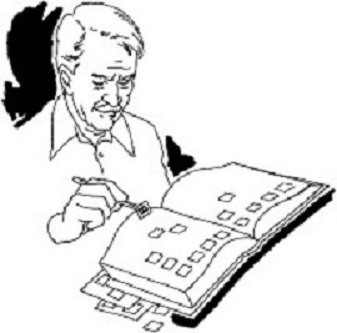|
Charity Seals, Stamp Packets, Postcards, Collectible Labels Philatelist and dealer in collectible Charity Seals such as Christmas Seals, Spring Seals, Local TB Seals, Foreign TB Seals, Easter Seals, Boys Town Seals, Charity Seals, and Charity Seal Literature. Plus, Cinderella Stamps, Topical and Foreign Stamp Packets, Disney Stamps, Stamp Collecting Supplies, Postcards, and Collectible Labels. |
Comb Perforation
Beginning in 1932, the Eureka Specialty Printing Company used a comb perforating machine with perforating pins built around each seal in two vertical columns, except for the right side of the right column. The overall pattern thus resembles a comb.
Five operations are necessary to perforate ten rows of a sheet. In each operation, the column of perforations at the far left fills in the missing row at the right, and no perforations overlap. Within each comb, the horizontal and vertical lines of perfs intersect to form a perfect bulls-eye. However, sheets can be found in which the separate applications were not aligned correctly and the individual combs are evident.
The distinctive appearance of Eureka seals during this period makes them easy to distinguish even without the aid of a perforation gauge. Where very accurate gauges are needed, take care not to measure perfs across two different combs.
Die cut
This refers to a cut through the seal paper (but not through the backing paper) of self-adhesive seals. This may be straight line die cut (producing seals that appear to be imperforate when separated) or serpentine die cut (producing rounded teeth which resemble perforations when the seals are separated). The gauge of the latter may be measured as for perforated seals. When the die cutting is discontinuous and tiny bridges of paper remain between adjacent seals, this may be called roulette die cut.
Imperforate
These seals or sheets have no perforations or rouletting at all. Proofs and essays are often imperf. In addition, due to collector demand, imperf sheets were regularly issued for a number of years. Imperf errors are also noted in the catalog. The listings and prices apply only to seals with no trace of a perforation or roulette on either side of the paper.
Pairs listed as vertical pair imperf between (VPIB) or horizontal pair imperf between (HPIB) are pairs of seals missing only one row or column of perforations, including those that were cut across the sheet gutter between uncut sheets of seals. The seals are perforated on the other 3 sides.
In contrast, pairs listed as vertical pair imperf horizontally or horizontal pair imperf vertically are missing all their horizontal or vertical perforations.
Line Perforation
This is a method of perforating where all parallel rows of perforations are done at the same time. This is the most common method of perforating seals. In contrast to comb perforations, the horizontal and vertical perfs intersect randomly.
Perf 12:00/Perf 14:00
Perf 12:00 means that although most of the perforations are gauge 12, these are interrupted by two (or sometimes one or three) larger and wider spaced perforations about once per seal. Typically, eleven regular perf 12 holes are between each pair of large holes, though examples may be found where the middle hole of the eleven normal perfs is also large.
Similarly, perf 14:00 seals typically have thirteen normal perf 14 holes between each pair of large holes. Perf 14:00 was used only in 1925.
Perf 12T
This refers to perforations created on a line-perforating machine in which parallel rows of horizontal and vertical perforations were applied in separate operations. For one of these operations, pins were removed so that only a single perf (rather than the normal overlapping double perfs) occurs where the rows cross. This variety occurs on 1930 and 1931 booklet panes made by Eureka Specialty Printing Company.
Roulette
Rouletted seals are separated by means of rows of tiny slits. These are intended to cut all the way through the seal paper (and in some cases, the self-adhesive backing paper as well), but remove no paper from the sheet. For some modern in-line sheets the knives were sometimes dull or out of adjustment and made only faint marks on the surface of the seals but did not cut the seals significantly. Such seals can be called "imperforate" only if no trace of the rouletting is present. The gauge of a roulette is measured, as for normal perforations, by looking at the spacing of the alternating cuts and bridges.
Simulated Perforations
These are rows of tiny circles printed in white, gray, black, or another contrasting color to give the appearance of perforations, but no paper is actually removed. The seals are usually separated by means of roulettes or die cuts, which may not line up with the simulated perfs.
Skip Perfs
This variety of syncopated perforations has been used since 1986 to reduce the likelihood of sheets unintentionally separating along the perforations on which they are folded. Typically, every third pin is removed, creating wider paper bridges between the perforations.
Syncopated Perforations
When all the perforations in one row are not uniform, they are referred to as syncopated perforations. Eureka Specialty Printing Company used them between 1917 and 1931. (See Perf 12:00/Perf 14:00.) Skip Perfs are another example.
Green's Catalog of the Tuberculosis Seals of the World, Part I, U.S. National Seals, 2010 ed. p.4


